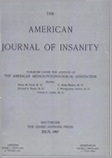ELECTROENCEPHALOGRAPHIC ANALYSES OF BEHAVIOR PROBLEM CHILDREN
Abstract
Electroencephalographic and clinical studies of 71 behavior problem children have been presented. Abnormalities in brain potentials were found in 71 per cent of this group with very marked abnormalities appearing in 59 per cent. Epileptiform electrical activity was observed in 39 per cent of the cases. These latter patients showed characteristic mental and emotional disturbances analogous to those often associated with the epileptic personality. In only two of these cases was epilepsy suspected previous to the electroencephalographic findings and none were having convulsions at the time of examination.
It is concluded that abnormal brain function as revealed by the electroencephalogram is an important component in the aetiological picture of the majority of a group of problem children whose disorder had been considered as primarily psychogenic previous to using this method of diagnosis. The nature of the fundamental pathology of the brain indicated is not as yet known, but the findings have been found important in evaluating prognosis and treatment.
Access content
To read the fulltext, please use one of the options below to sign in or purchase access.- Personal login
- Institutional Login
- Sign in via OpenAthens
- Register for access
-
Please login/register if you wish to pair your device and check access availability.
Not a subscriber?
PsychiatryOnline subscription options offer access to the DSM-5 library, books, journals, CME, and patient resources. This all-in-one virtual library provides psychiatrists and mental health professionals with key resources for diagnosis, treatment, research, and professional development.
Need more help? PsychiatryOnline Customer Service may be reached by emailing [email protected] or by calling 800-368-5777 (in the U.S.) or 703-907-7322 (outside the U.S.).



